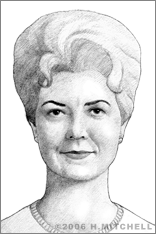Bette Graham
Typists who are prone to making mistakes when using old-fashioned typewriters or word processors have Bette Nesmith Graham to thank for creating one of the most simple, yet lifesaving inventions in all of office-supply history: Liquid Paper.
Born Bette Clair McMurry in Dallas, Texas on March 23, 1924, this high-school dropout married Warren Nesmith at the age of 19 and worked as a secretary while earning her GED in night school. While her husband was away in service during World War II, she gave birth to a son, Michael, who would later become a guitarist for the band "The Monkees." After her husband returned from the war, the couple divorced, and Nesmith found herself a single mother, left to raise her son alone.
Nesmith had not actually wanted to be a secretary. She was much more interested in art, and in her free time she dabbled in painting and drawing. However, she became adept at her profession, and by 1951, she was working as an executive secretary for the chairman of the board of Texas Bank and Trust.
At that time, electric typewriters were becoming more and more popular, and in learning to use them, Nesmith and other secretaries often made mistakes that they found difficult to erase, in part because of the messy carbon-film ribbons used in the devices. Nesmith knew that artists were accustomed to simply painting over their mistakes with more paint. She thought, why not do the same to cover mistakes made in typewritten ink?
Nesmith came up with a very simple formula that she began making in batches to use at work. Using her kitchen blender, she mixed up some tempera water-based paint, tinting it to match her company stationery. She took it to the office with a watercolor brush, and whenever she made a mistake on paper, she simply painted over it and fixed the error.
The formula worked like magic. In fact, her boss never even noticed the corrected errors in her work. It wasn’t long before other secretaries at her company found out about the ingenious solution that she had created. When they began asking her to use some of the fluid, she began making up bottles, putting labels on them that read “Mistake Out,” and giving them to friends.
Nesmith soon realized that the product was popular enough to form the basis for a business. She started the Mistake Out Company in 1956 in her home, mixing the fluid in her kitchen and employing her son and his friends to fill bottles for customers. When she became too engrossed in her own business, her boss at the bank fired her. It was a blessing in disguise. Now she could devote all her time to the Mistake Out business.
Nesmith patented the product, renamed it “Liquid Paper,” and obtained a trademark. Before long, she was selling around 100 bottles of Liquid Paper per month. In 1957, a magazine called The Office mentioned the product, and General Electric placed a large order. Soon, business was booming. Nesmith married Robert Graham in 1962, and he joined the business as well. By 1967, Liquid Paper was a million-dollar enterprise. In 1968, Nesmith Graham opened a new plant with 20 employees. That year, she sold one million bottles.
In 1975, Nesmith Graham divorced her husband. That same year, she opened a 35,000-square-foot headquarters building for Liquid Paper in Dallas. A year later, the company’s net earnings were $1.5 million, and the product was being sold in 31 countries around the world. Nesmith Graham was innovative in establishing her company culture, encouraging employees to participate in making corporate decisions and setting up an in-plant library and child-care center. She also used a portion of her fortune to set up two foundations to help women in need: the Gihon Foundation, established in 1976, and the Bette Clair McMurray Foundation, founded in 1978.
In 1979, she sold her company to the Gillette Corporation for $47.5 million. A year later, she passed away at the age of 56.


